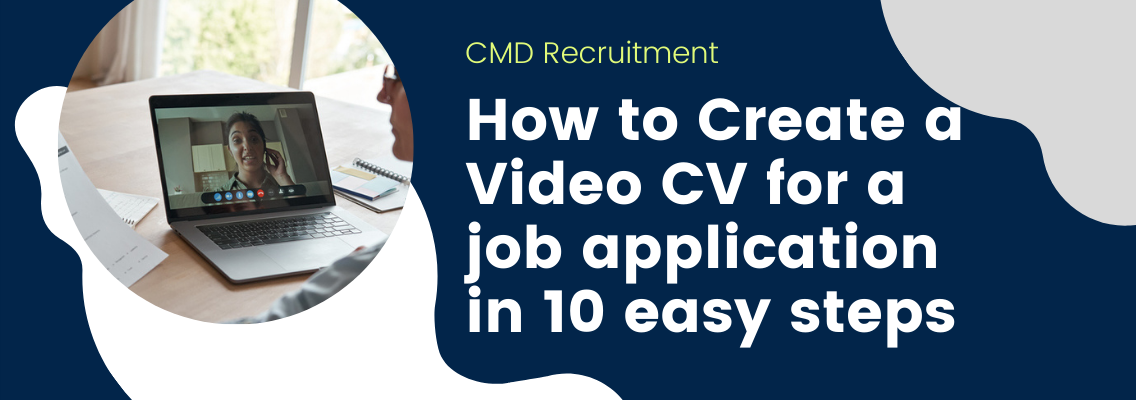Important notice - We are aware of a scam where people are impersonating CMD Recruitment to offer jobs via WhatsApp & Telegram. This is a scam, CMD Recruitment will never contact new candidates via these methods. Any legitmate offer from CMD Recruitment would be made via a telephone call.

October 13, 2021
You might notice a lot more employers are offering the opportunity to apply for a job using a video. If you’re outgoing and like a creative challenge, this can be an excellent way to stand out from the other applicants.
If you’re curious about how to create a video CV, read on to learn our top tips for making this process as simple as possible. The first time you create a video CV might take a little longer, but once you have a system in place, you’ll be able to quickly produce professional-looking videos in place of a CV.
A video CV takes the place of the traditional paper CV. Instead of listing your achievements on paper, you talk about them in a more conversational style. A video CV can also be highly creative, which is ideal if you’re applying for a role in the creative sector.
A video CV typically lasts between 30 seconds and two minutes. Like a paper CV, you should use this time to talk about your education, work experience and your skills. There’s a lot less room to hide on a video CV – so if you say you have excellent communication skills, you’re going to have to back up this claim.
This all depends on the job role. You don’t have to wait for employers to request a video CV. According to one study, employers are open to receiving them, even if they haven’t asked for a CV in this format.
If you want to stand out, submitting your CV in video format could help you land an interview. But this all depends on the company. Some won’t even bother viewing a video CV if they have specifically asked for your CV in a different format.

It takes a little bit of preparation to get into the habit of creating a video CV. Remember that your CV still needs to be tailored to each role you apply for. You can create a general video CV to add to your LinkedIn profile, but if you’re sending it to a specific company, you need to mention their name. If you’re ready to get started creating your video CV, you’ll need to follow these ten steps.
You might think you have the gift of the gab, but don’t even think about starting your video CV without a script in front of you. You’ll be prone to waffling and missing things out if you don’t first consider what you will say.
In your script, you should introduce yourself and then talk about your history, including your education and relevant work history. Next, talk about where you want to go next and why you are applying for the role. You can also mention any additional skills you want the hiring manager to know about.
Finally, conclude the script by thanking them for their time and mention how they can reach you. This is a great touch for speculative CVs.
Always, always, always tailor the script to the job you are applying for. Nothing will lose a hiring manager’s attention faster than realising they’ve been sent a generic video. Mention the company by name, mention the role you are applying for, and outline why you are interested in being considered for the role.
This is an excellent opportunity to demonstrate your passion for your industry and why you would be great for the role. You don’t have to record the whole thing in one take. If you’re confident with editing software, you could change the company and job title as required. Just make sure you’re in the same place and wearing the same outfit when you do this!
Finding a good location to film is essential. You want to look professional but personable. Finding a quiet corner in your home is one option, or you could film while you’re out and about. If you’re feeling creative, filming it while walking down the street could be very effective.
You should find someone with good natural lighting so that you don’t have harsh shadows on your face. You also want to eliminate background noise as much as possible so the hiring manager can focus on what you have to say.
You don’t need a professional camera to get great results. A smartphone and tripod should be sufficient if you don’t want to capture multiple angles. However, you should consider investing in a good microphone. This will help ensure your voice is crisp and clear and help eliminate background noise.
If you decide to capture multiple angles, you may want to borrow a second phone or invest in a DSLR. This will allow you to get professional results and be far more creative with the editing.
If you’re not used to being on camera, it can take a while to get used to it. Start by just filming yourself talking, and then start talking through your script. Watch it back and look for any mistakes you might be making. You want to talk directly into the camera, so if you find your eyes wandering to your script, try to correct this.
You should also be on the lookout for any nervous behaviour you might have. For example, some people pepper their speech with “umms” or “likes”, while others play with their hair or tap their fingers. Keep recording yourself and watching it back until you have a) got used to the sound of your voice and b) stopped any bad habits.
Don’t get hung up on trying to get the whole video done in one take. Instead, keep the camera rolling and keep trying until you’ve said what you want. Then, when you’re done filming, you can go through and piece together the best cuts. If you’re trying to show off your editing skills, this is a great way to do it.
It’s also helpful to be able to adjust the video CV to different employers. As long as you keep the set up the same and wear the same clothing, you can return later and add new company and job details if your first application wasn’t successful.
Filming from different angles is a great way to keep your video visually interesting. For example, place one camera directly in front of you and then one off to the side – your good side. You can then create a documentary-style video that will also allow you to introduce edits more easily.
This means that employers won’t know if you filmed the whole thing in one take because the cuts between the video will conceal any changes. Look at how YouTubers achieve this effect if you’re not sure how to do it.
Your video CV doesn’t have to be two minutes of talking about your last job; you can get creative and show footage of yourself in different situations. For example, if your hobbies outside of work are directly related to your work, why not include footage of this with a voiceover?
You could also show yourself actually doing your job, particularly if it’s a creative or visual role. And finally, if you’re applying for a role in film or editing, you can afford to be as creative as you like with the video CV.
Now you should have more footage than you could possibly need. It’s time to cut it down and create a cohesive video. You can use free video editing software to create basic cuts in your footage and switch between different angles. You can also include footage of you at work or taking part in relevant hobbies.
Remember that this video is supposed to be a comprehensive introduction to you. Think about what you want a prospective employer to know about you, and then make sure this comes across in the final edit. It would help if you also asked friends and family for a second opinion to ensure the final product is polished and professional.
You now have a finished video ready to share with employers. Consider adding a generic video CV to your LinkedIn page to allow recruiters and employers to get to know you better. You could also upload your video CV to YouTube. This will allow you to easily share your video with recruiters and companies without having to send large files attached to emails. Once it is on YouTube, you can also add subtitles to make your video more accessible.
Always let the recipient know that you’re sharing a video CV when you send them a link, as they might be reluctant to click on links in emails without further context. You should also avoid using a link shortener like bit.ly, as this might be flagged as spam.
Back to Blog